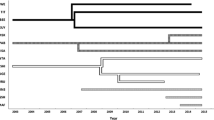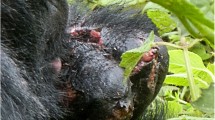Abstract
Six unrelated male gorillas formed an all-male group within the Virunga mountain gorilla population. Frequent homosexual interactions characterized the high cohesiveness of this group. Such homosexual behavior reduced the inter-individual distances and increased the social tension between the two silverbacks in the group. The silverbacks retained “ownership” of the homosexual partners, but competed and fought with each other violently when the partners avoided or ignored their courtship. Neither submissive nor reassurance behavior was noted between the silverbacks. Thus, their relationships may not be explained in terms of dominance and subordinancy. However, the loser-support and mediating behavior observed in the group prevented them from engaging in severe fights. Aggression was always directed from the elder and dominant males to the younger and subordinate males, while supporting interactions occurred in the opposite direction. The blackbacks frequently supported the subadult aggressees by attacking the silverbacks, and the younger males displayed mediating behavior in violent fights between the silverbacks. The group's ranging was influenced by encounters with neighboring social units. The members avoided contact with other units and shifted their range after several encounters. On the other hand, when and after a subadult male had immigrated into their group, they frequently encountered other units and did not move away from the encounter site. An all-male group may not be a favorable unit for females to transfer to, but may be profitable for maturing males to associate with. Its formation is probably related to recent social change in the Virunga gorilla population.
Similar content being viewed by others
References
Altmann, S. A. &J. Altmann, 1970.Baboon Ecology. Univ. of Chicago Press, Chicago.
Bernstein, I. S., 1970. Primate status hierarchies. In:Primate Behavior: Developments in Field and Laboratory Research, Vol. 1,L. A. Rosenblum (ed.), Academic Press, New York, pp. 71–109.
Bertrand, M., 1969.The Behavioural Repertoire of the Stumptail Macaque. Bibliotheca Primatologica Vol. 11, S. Karger, Basel.
Boelkins, R. C. &R. P. Wilson, 1972. Intergroup social dynamics of the Cayo Santiago rhesus (Macaca mulatta) with special reference to changes in group membership by males.Primates, 13: 125–140.
Bourliere, F., M. Bertrand, &C. Hunkeler, 1970. The ecology and behavior of Lowe's guenon (Cercopithecus campbelli lowei) in the Ivory Coast. In:Old World Monkeys,J. R. Napier &P. H. Napier (eds.), Academic Press, New York, pp. 297–350.
Caro, T. M., 1976. Observations on the ranging behaviour and daily activity of lone silverback mountain gorillas (Gorilla gorilla beringei).Anim. Behav., 24: 889–897.
DeVore, I., 1965. Male dominance and mating behavior in baboons In:Sex and Behavior,F. Beach (ed.), Wiley, New York, pp. 266–289.
De Waal, F. B. M., 1978. Exploitative and familiarity-dependent support strategies in a colony of semi-free living chimpanzees.Behaviour, 66: 268–312.
————,J. A. R. M. van Hooff, &W. J. Netto, 1976. An ethological analysis of types of agonistic interaction in a captive group of Java-monkeys (Macaca fascicularis).Primates, 17: 257–290.
Elliott, R. C., 1976. Observations on a small group of mountain gorillas (Gorilla gorilla beringei).Folia Primatol., 25: 12–24.
Fossey, D., 1972. Vocalizations of the mountain groilla (Gorilla gorilla beringei).Anim. Behav., 20: 36–53.
————, 1974. Observations on the home range of one group of mountain gorillas (Gorilla gorilla beringei).Anim. Behav., 22: 568–581.
————, 1979. Development of the mountain gorilla (Gorilla gorilla beringei) through the first 36 months. In:The Great Apes,D. A. Hamburg &E. R. McCown (eds.), Benjamin/Cummings, Menlo Park, Calif., pp. 139–186.
————, 1981. The imperiled mountain gorilla.Nat. Geogr., 159: 501–523.
————, 1982. Reproduction among free-living mountain gorillas.Amer. J. Primatol. Suppl., 1: 97–104.
————, 1983.Gorillas in the Mist. Houghton Miffilin Co., Boston.
———— &A. H. Harcourt, 1977. Feeding ecology of free-ranging mountain gorilla (Gorilla gorilla beringei). In:Primate Ecology: Studies of Feeding and Ranging Behaviour in Lemurs, Monkeys and Apes,T. H. Clutton-Brock (ed.), Academic Press, London, pp. 415–447.
Gartlan, J. S. &S. C. Gartlan, 1973. Quelques observations sur les groupes exclusivement males chezErythrocebus patas.Ann. Fac. Sci. Cameroun, 12: 121–144.
Goodall, J., 1975. Chimpanzees of the Gombe Stream Reserve. In:Primate Behavior,I. DeVore (ed.), Holt, Rinehart, & Winston, New York, pp. 425–473.
————, 1968. The behaviour of free-living chimpanzees in the Gombe Stream Reserve.Anim. Behav. Monogr., 1(3): 161–311.
————, 1971.In the Shadow of Man. Houghton Mifflin Co., Boston.
Gordon, T. P. &I. S. Bernstein, 1973. Seasonal variation in sexual behavior of all-male rhesus troops.Amer. J. Phys. Anthropol., 38: 221–225.
Handler, N. T., R. K. Malenky, &N. Badrian, 1984. Sexual behavior ofPan paniscus under natural conditions in the Lomako forest, Equateur, Zaïre. In:The Pygmy Chimpanzee: Evolutionary Biology and Behavior,R. L. Susman (ed.), Plenum Press, New York & London, pp. 347–368.
Harcourt, A. H., 1978a. Activity periods and patterns of social interaction: a neglected problem.Behaviour, 66: 121–135.
————, 1978b. Strategies of emigration and transfer by primates, with particular reference to gorillas.Z. Tierpsychol., 48: 401–420.
————, 1979. Social relationships among adult female mountain gorillas.Anim. Behav., 27: 251–264.
————, 1981. Intermale competition and the reproductive behavior of the great apes. In:Reproductive Biology of the Great Apes,E. E. Graham (ed.), Academic Press, New York, pp. 301–318.
————,K. J. Stewart, &D. Fossey, 1976. Male emigration and female transfer in wild mountain gorilla.Nature, 263: 226–227.
————, & ————, 1981. Gorilla reproduction in the wild. In:Reproductive Biology of the Great Apes,E. E. Graham (ed.), Academic Press, New York, pp. 265–279.
Hess, J. P., 1973. Some observations on the sexual behaviour of captive lowland gorillas,Gorilla g. gorilla (Savage andWyman). In:Comparative Ecology and Behaviour of Primates,R. P. Michael &J. H. Crook (eds.), Academic Press, London, pp. 507–581.
Hrdy, S. B., 1974. Male-male competition and infanticide among the langurs (Presbytis entellus) of Abu Rajasthan.Folia Primatol., 22: 19–58.
Itani, J., 1977. Evolution of primate social structure.J. Human Evol., 6: 235–243.
————, 1980. Social structure of African great apes.J. Reprod. Fertil. Suppl., 28: 33–41.
———— &K. Tokuda, 1958. The monkeys of Koshima islet.Nihondobutsuki, Vol. 3,K. Imanishi (ed.), Kobunsha, Tokyo. (in Japanese)
Jay, P., 1965. The common langur of north India. In:Primate Behavior: Field Studies of Monkeys and Apes.I. DeVore (ed.), Holt, Rinehart, & Winston, New York, pp. 197–249.
Kano, T., 1980. Social behavior of wild pygmy chimpanzees (Pan paniscus) of Wamba: A preliminary report.J. Human Evol., 9: 243–260.
Kaplan, J., 1977. Patterns of fight interference in free-ranging rhesus monkeys.Amer. J. Phys. Anthropol., 47: 279–288.
Kaufmann, J. H., 1965. A three-year study of mating behavior in a free-ranging band of rhesus monkeys.Ecology, 46: 500–512.
Kummer, H., 1968.Social Organization of Hamadryas Baboons. Univ. of Chicago Press, Chicago.
Kurland, J. A., 1977.Kin Selection in the Japanese Monkey. Contributions to Primatology, Vol. 12, S. Karger, Basel.
Kuroda, S., 1980. Social behavior of the pygmy chimpanzee.Primates, 21: 181–197.
Morgan, B. J. T., M. J. A. Simpson, J. P. Hanby, &J. Hall-Craggs, 1976. Visualizing interaction and sequential data in animal behavior: Theory and application of cluster-analysis methods.Behaviour, 59: 1–43.
Mori, U., 1979. Development and sociability and social status. In:Ecological and Sociological Studies of Gelada Baboons,M. Kawai (ed.), Kodansha-Karger, Tokyo, pp. 4–45.
Nadler, R. D., 1986. Sex-related behavior of immature wild mountain gorillas.Develop. Psychobiol. 19(2): 125–137.
Nishida, T., 1970. Social behavior and relationship among wild chimpanzees of the Mahali mountains.Primates, 11: 47–87.
————, 1983. Alpha status and agonistic alliance in wild chimpanzees (Pan troglodytes schweinfurthii).Primates, 24: 318–336.
Norikoshi, K. &N. Koyama, 1975. Group shifting and social organization among Japanese macaques. In:Proceedings from the Symposia of the Fifth Congress of the International Primatological Society,S. Kondo,M. Kawai,A. Ehara, &S. Kawamura (eds.), S. Karger, Basel, pp. 43–62.
Packer, C., 1977. Reciprocal altruism inPapio anubis.Nature, 265: 441–443.
Riss, D. &J. Goodall, 1977. The recent rise to the alpha-rank in a population of free-living chimpanzees.Folia Primatol., 27: 134–151.
Rowell, T. E., 1966. Hierarchy in the organization of a captive baboon group.Anim. Behav., 14: 430–443.
Schaller, G. B., 1963.The Mountain Gorilla: Ecology and Behavior. Univ. of Chicago Press, Chicago.
Seyfarth, R. M., 1976. Social relationships among adult female baboons.Anim. Behav., 24: 917–938.
Simonds, P. E., 1965. The bonnet macaque in south India. In:Primate Behavior: Field Studies of Monkeys and Apes,I. DeVore (ed.), Holt, Rinehart, & Winston, New York, pp. 175–196.
Struhsaker, T. T., 1967. Social structure among vervet monkeys (Cercopithecus aethiops).Behaviour, 29: 83–121.
Vandenbergh, J. G., 1973. Environmental influences on breeding in rhesus monkeys. In:Primate Reproductive Behavior (Symp. 4th Int. Congr. Primatol.),C. H. Phoenix (ed.), S. Karger, Basel, pp. 1–19.
Vedder, A., 1984. Movement patterns of a group of free-ranging mountain gorillas (Gorilla gorilla beringei) and their relation to food availability.Amer. J. Primatol., 7: 73–88.
Watanabe, K., 1979. Alliance formation in a free-ranging troop of Japanese macaques.Primates, 20: 459–474.
Watts, D. P., 1984. Composition and variability of mountain gorilla diets in the central Virungas.Amer. J. Primatol., 7: 323–356.
Yamagiwa, J., 1983. Diachronic changes in two eastern lowland gorilla groups (Gorilla gorilla graueri) in the Mt. Kahuzi region, Zaïre.Primates, 24: 174–183.
————, 1986. Activity rhythm and the ranging of a solitary male mountain gorilla (Gorilla gorilla beringei).Primates, 27: 273–282.
Author information
Authors and Affiliations
About this article
Cite this article
Yamagiwa, J. Intra- and inter-group interactions of an all-male group of virunga mountain gorillas (Gorilla gorilla beringei). Primates 28, 1–30 (1987). https://doi.org/10.1007/BF02382180
Received:
Accepted:
Issue Date:
DOI: https://doi.org/10.1007/BF02382180




